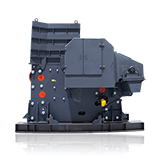How Does a Mobile Crusher Work?
In the world of construction, mining, and recycling, mobile crusher has become indispensable equipment for improving operational efficiency and reducing costs. These versatile machines are designed to work on-site, eliminating the need to transport raw materials to stationary processing plants. A mobile crusher is an effective solution for industries that require on-site material crushing and processing, such as demolition, recycling, and quarrying. But how exactly does a mobile crusher work? In this article, we'll take a closer look at the key components of a mobile crusher, its operation, and the advantages it offers.

What is a Mobile Crusher?
A mobile crusher is a type of crushing equipment that can be easily transported and operated at different locations. Unlike traditional stationary crushers, mobile crushers are designed to move between various work sites, making them a popular choice for projects that involve crushing and processing materials on-site. They are commonly used for breaking down large rocks and debris into smaller, more manageable sizes.
There are various types of mobile crushers, including mobile jaw crushers, impact crushers, cone crushers, and even mobile screening plants. Each type of mobile crusher is equipped with different features and components, tailored to handle specific tasks and materials.
Components of a Mobile Crusher
A mobile crusher typically consists of several key components:
- Chassis: The base frame that supports all other components and allows for mobility. It is equipped with wheels or tracks for easy transportation.
- Feeding System: A hopper or feeder that holds the material to be crushed and feeds it into the crusher unit at a controlled rate.
- Conveyor System: Belts or conveyors that transport the crushed material to a designated location, such as a stockpile or another processing unit.
- Power Source: Mobile crushers can be powered by diesel engines, electric motors, or hybrid systems, providing the necessary energy to operate the equipment.
- Control System An operator interface that allows for monitoring and controlling the crusher's operations, including adjustments to settings and monitoring performance.

How Mobile Crusher Works: Step-by-Step Process
A mobile crusher operates in a few essential steps, transforming raw materials into smaller sizes suitable for transport, storage, and further processing. Here’s an in-depth look at how a mobile crusher works.
1. Feeding Material
The first step in the process involves feeding the material into the mobile crusher. This is typically done through a hopper, which acts as a container that holds the raw materials before they enter the crushing chamber. The hopper can be loaded manually or with the help of equipment such as a front-end loader or conveyor belt.
Once inside the hopper, the material is transported to the primary crusher via a conveyor belt. The design of the hopper is often customizable to suit the type and size of material being processed.
2. Crushing Mechanism
Once the material is inside the mobile crusher, the primary crushing mechanism begins. Different mobile crushers feature different crushing technologies, depending on the type of material and desired product size. The most common types of crushers used in mobile units are jaw crushers, impact crushers, and cone crushers.
- Jaw Crushers: Jaw crushers are typically the primary crushers used in mobile equipment. They work by compressing the material between two jaws—one fixed and one movable. The material is fed into the top of the jaws, and the gap between them gradually narrows as the movable jaw moves. The pressure from the jaws forces the material to break into smaller pieces.
- Impact Crushers: Impact crushers, on the other hand, use high-speed impact forces to break down materials. As material is fed into the crusher, it is struck by a rotating rotor or hammers. These hammers deliver powerful blows, shattering the material and causing it to break into smaller pieces.
- Cone Crushers: Cone crushers operate by compressing the material between a rotating cone and a fixed cone. The material is fed into the top of the machine and gradually moves downward, where it is crushed by the force of the rotating cone. Cone crushers are ideal for producing smaller, more uniform material sizes.

3. Screening and Separation
After the material is crushed, it typically undergoes a screening process to separate the finer material from the larger pieces. Some mobile crushers come with integrated screening equipment, which includes vibrating screens or drum screens, that separate the crushed material into different size categories.
- Vibrating Screens: Vibrating screens are commonly used in mobile crushers to sort materials into different grades based on size. The screen is designed to vibrate rapidly, causing the crushed material to pass through the mesh and separate into finer and larger fractions.
- Drum Screens: In some mobile crushers, a rotating drum screen is used to separate materials. This type of screen is effective for materials that are mixed with dirt or debris, helping to clean and grade the crushed material.
4. Discharge of Crushed Material
After the crushing and screening processes, the material is discharged and ready for transport or further processing. The crushed material is typically transported via conveyor belts, which can move it directly to the next stage of processing or to a stockpile. In some cases, the material is discharged directly onto the ground, ready to be loaded into trucks or sent for further treatment.
5. Mobility and Transportation
The defining feature of a mobile crusher is its ability to move between different locations with ease. Mobile crushers are typically mounted on tracks or wheels, allowing them to travel from one job site to another without the need for disassembly or reassembly. The mobility of these machines makes them especially useful for projects where materials need to be crushed on-site, such as in construction, mining, and demolition.
Depending on the type of mobile crusher, the equipment may be designed to travel on tracks (tracked crushers) or wheels (wheeled crushers). Tracked crushers are more suited for rough terrain and difficult-to-access areas, while wheeled crushers are typically used for jobs that involve smoother, more accessible paths.
6. Power Source
Mobile crushers are typically powered by either diesel engines or electric motors. Diesel-powered mobile crushers are more common in remote locations where electricity is not readily available. These engines drive all of the components of the mobile crusher, including the feeder, crusher, conveyor belts, and screens.
Electric-powered mobile crushers, on the other hand, are more efficient and produce less emissions. They are commonly used in more urban settings where environmental regulations may be more stringent. Some mobile crushers may also feature hybrid power systems, which combine both electric and diesel power sources.
Advantages of Mobile Crushers
Mobile crushers offer numerous benefits for industries involved in material processing. Here are some key advantages of using mobile crushers:
- On-Site Crushing: Mobile crusher can be transported directly to the work site, allowing materials to be processed on-site, reducing transportation costs, and saving time.
- Flexibility and Mobility: Mobile crusher can be moved easily from one location to another, offering flexibility in terms of project scope and location.
- Reduced Transportation Costs: By processing materials on-site, mobile crusher eliminate the need for hauling large amounts of material to distant processing plants, which can be expensive and time-consuming.
- Lower Energy Consumption: Mobile crushers are often more energy-efficient than traditional stationary crushers, as they require less energy to transport materials.
- Ease of Setup: Setting up a mobile crusher is quick and easy, allowing for rapid deployment at new job sites with minimal downtime.
In conclusion, mobile crushers play a critical role in industries such as construction, mining, and demolition by providing a highly effective and efficient way to process materials on-site. Their mobility, versatility, and ability to reduce transportation costs make them a valuable asset to any project. Whether you are looking to break down rocks in a quarry, process recycled materials, or handle demolition debris, a mobile crusher is an excellent solution for streamlining operations and improving productivity.
By understanding the key components of mobile crushers and their operational process, companies can make more informed decisions when choosing the right equipment for their needs, ultimately improving efficiency and profitability in the long run.







